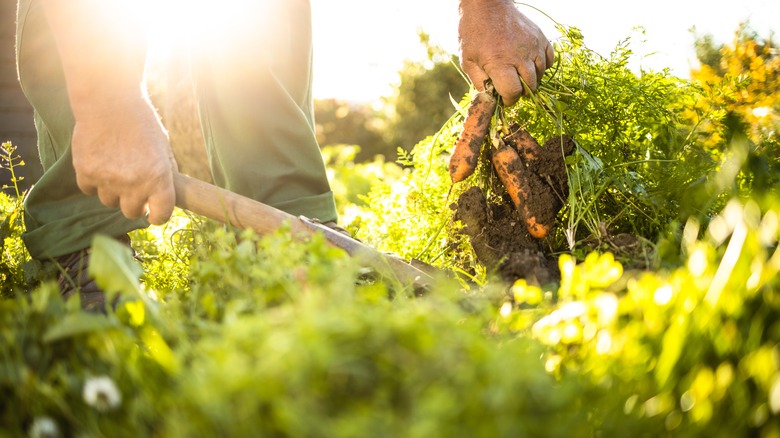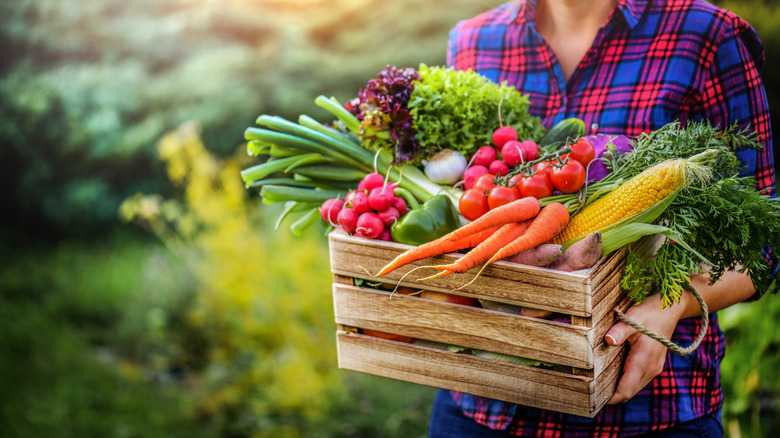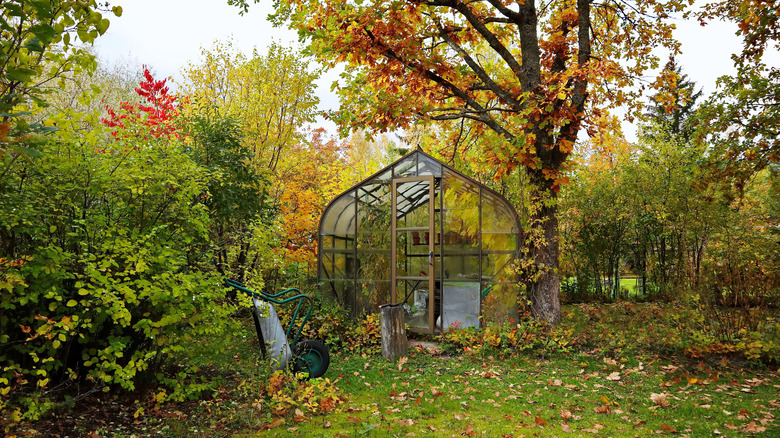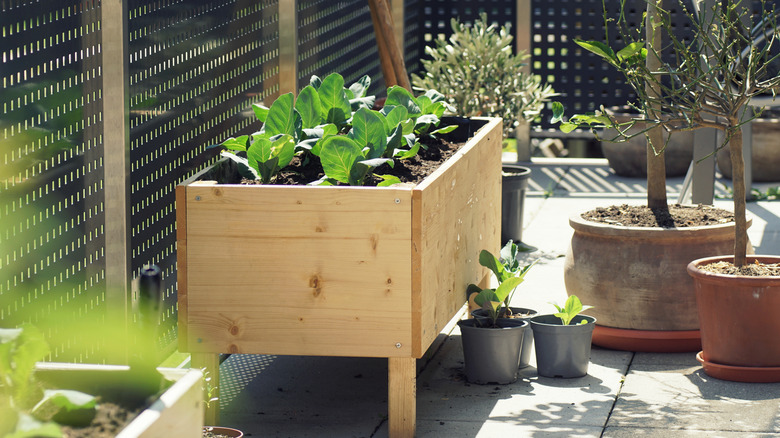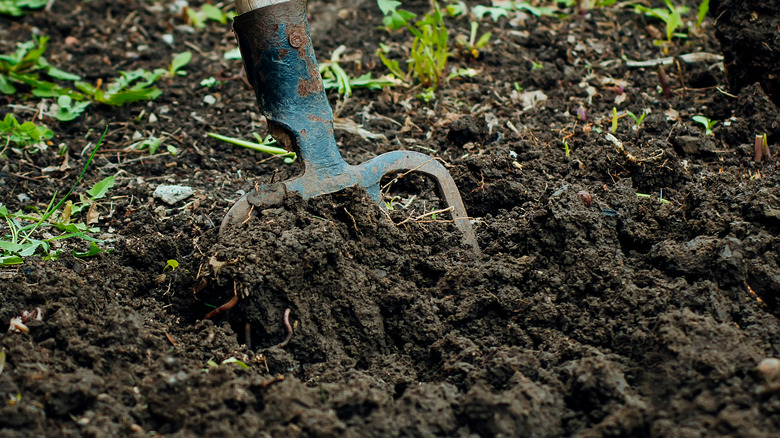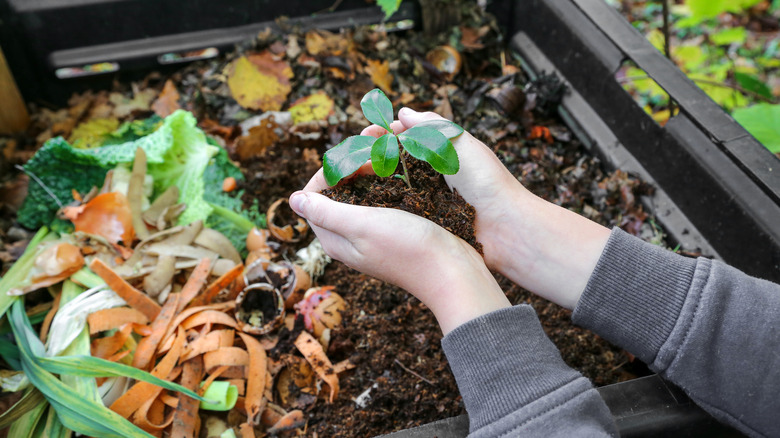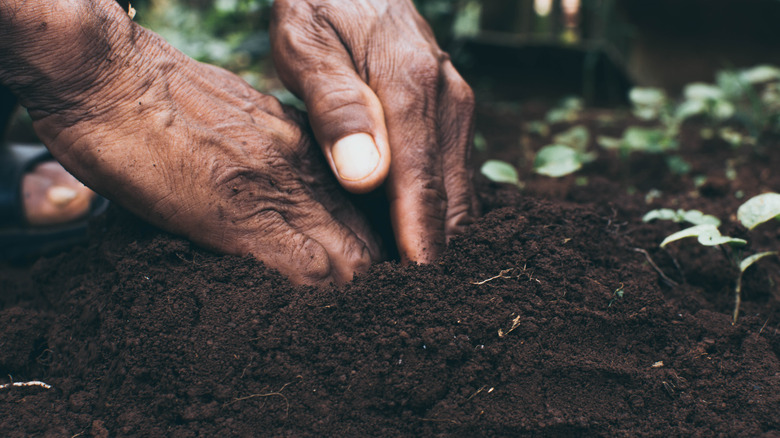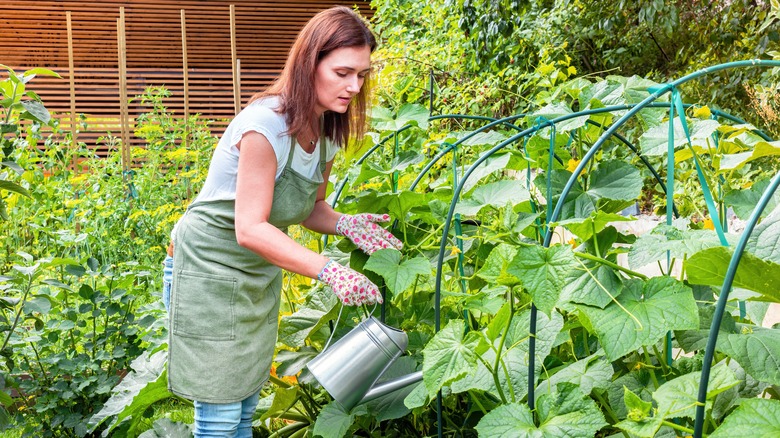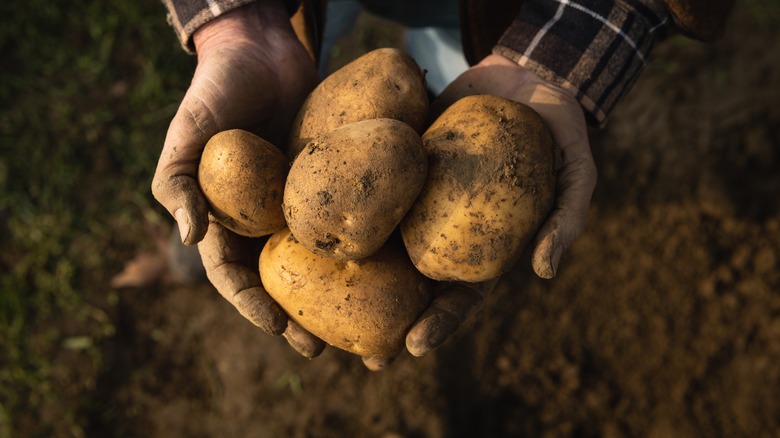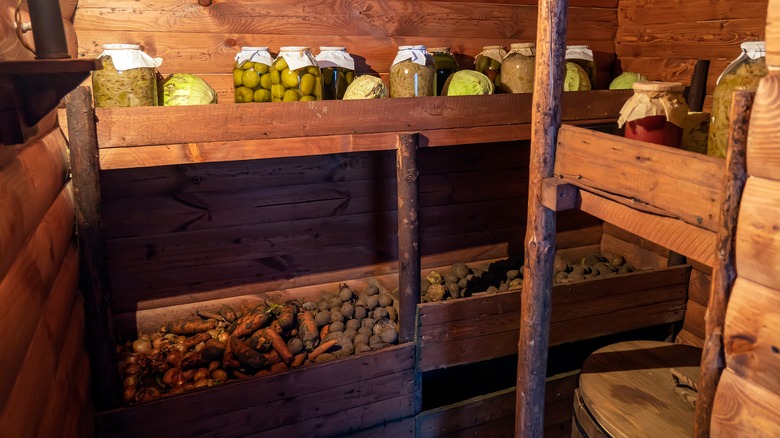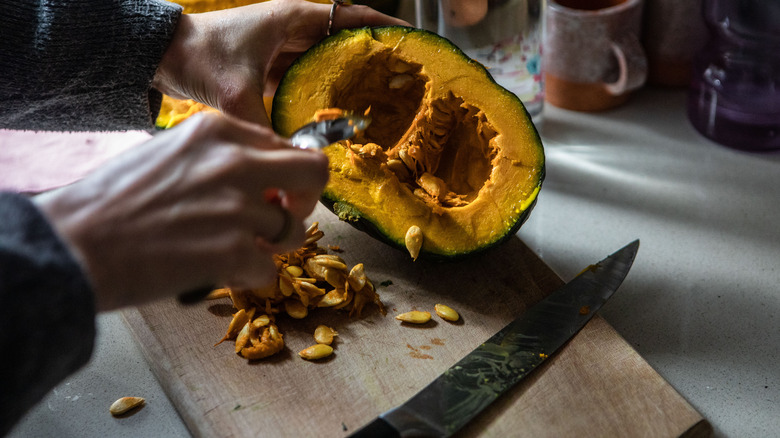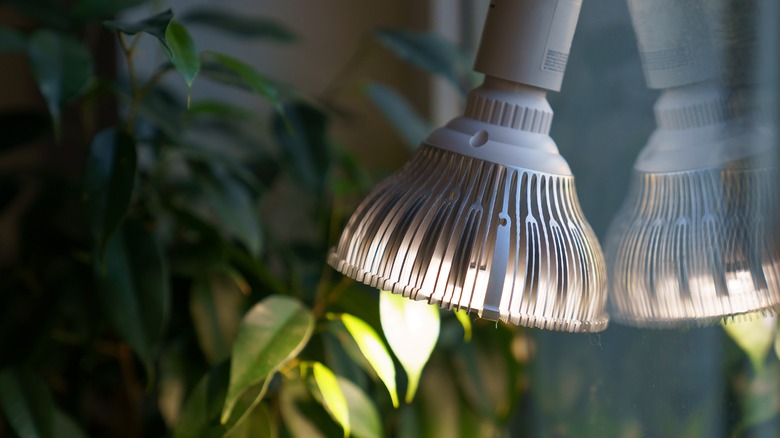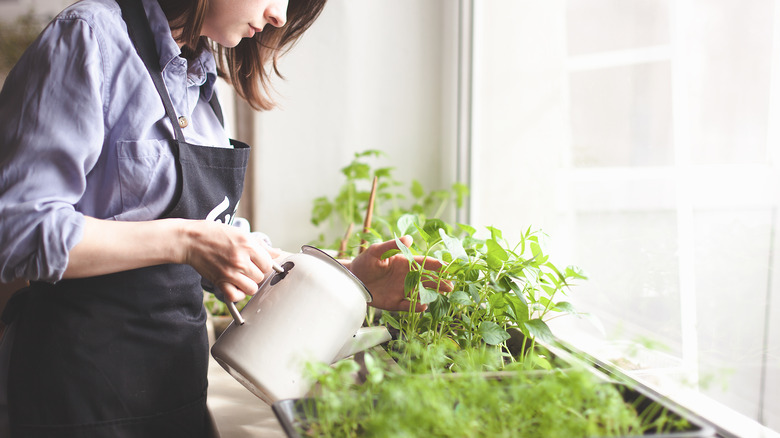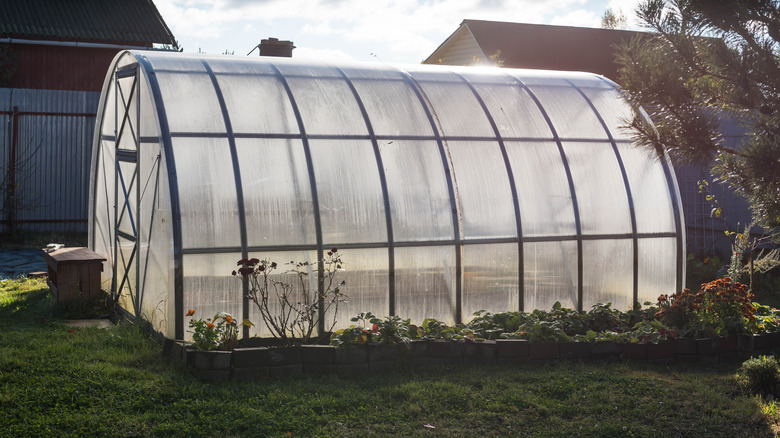How To Plant A Fall Vegetable Garden
Most people start perusing the seed catalog in early spring, hoping for a late summer crop. However, you can also plant a fall vegetable garden and continue enjoying fresh, healthy treats into the winter. There are many benefits to planting a fall garden beside the fact that you'll reap a beautiful harvest. GardenTech explains that you have warmer soil temperatures in the fall, unlike in spring when you are waiting for the final frost to come and go. There are also fewer weeds and pests to deal with in the fall. And just like the lawn, fall is the best time of year to fertilize your garden.
The cooler fall temperatures cause the growth of things above ground to slow down, which means plants can focus their energy on what's below — the roots. So, go ahead and chase away the dreary thoughts of summer disappearing. Fall is here, and along with the beautiful color changes, you can start planning your fall garden.
Which vegetables can you plant in the fall?
You can grow just about anything in the summer, but what grows best in the fall months? There are, of course, the two obvious answers, pumpkins and winter squash. Many people plant or buy them because they are iconic symbols of fall and are used to decorate porches and fireplace mantels as soon as the first leaves start to change. However, pumpkins and winter squash are really good for you, according to Michigan State University. They are a low-fat treat, full of vitamins A and C, and plenty of fiber.
Other than pumpkins and winter squash, root vegetables are your next best bet for fall. As mentioned, in the cooler months, plants are able to focus their energy underground where the roots grow, making root veggies an excellent choice. Some possible root vegetables are beets, carrots, radishes, and turnips, per GrowVeg. Wisconsin Potato & Vegetable Growers Association writes that potatoes, although not root vegetables, grow well in the fall, too, since they are underground. Onions and garlic, which are considered bulbs, are also excellent choices for your fall garden, according to WebMD.
When can you start your fall garden?
When to prepare your fall garden depends on where you live. It's helpful to understand the different climate zones. PlantingTree explains that there are nine zones in the U.S., ranging from zone 2, which is the coldest, to zone 10, which is the warmest. It's important to figure out which zone you live in, so you'll understand what grows best in your area.
Plants are often labeled "hardy" for a certain zone, which means they grow well there. Find out your zone, and then you'll know when you can begin your fall garden. If you live where there is a long summer or no fall at all, some fall crops may not grow well near you because they need that cold snap through the winter. If you experience all four seasons, it's important to find out when fall is expected to stay for good, with no more heat, and when the first frost is expected. Planning ahead and understanding where you live is your first step toward a healthy fall garden.
Where will you put the garden?
There are other options for an outdoor garden in the fall other than straight in the ground. If you don't have good soil or the space to take up in your yard for a garden, consider raised beds or a container garden. Coop explains that root vegetables need plenty of room for their roots to grow. The soil must be loose and never compact, or the roots have nowhere to go. It's possible to get this loose soil in a raised bed because raised beds aren't walked on the way your soil in the yard is. This helps the dirt not to become compacted.
Container gardens work the same way as long as you ensure not to pack the soil too tightly into the container. Fall gardens need plenty of drainage, so make sure raised beds have good, aerated soil with room to drain and containers have holes in the bottom. Build raised beds at least eight to 10 inches high and make sure containers are at least 12 inches deep to allow for root growth, per DIY & Crafts. Containers may not be able to handle pumpkins or winter squash which need room to crawl, but they can handle other root vegetables.
What type of soil do you have?
Just as in the summer, when planting a fall garden, you must prepare the soil. Taking the time for this early step will yield better results. The first part of preparing the ground is understanding what kind of soil you have. According to SummerWinds Nursery, there are several types: saline, peaty, sandy, clay, and silty. Sandy and saline soils lose water quickly, so they need moisture, while peaty, clay, and silty soils retain moisture. There are also soils known as alfisols, which are found in the Midwest region of the U.S. and formed naturally from native forests, per Farm Progress. This soil is some of the best in the world. The change of seasons, which brings the fall of leaves, helps to add extra nutrients to the ground. And the snow is a perk as well. While everyone complains about how cold it is, the snow is a blanket of warmth and additional moisture for the Midwest soil, according to Adirondack Almanac.
Knowing what type of soil you have is important to understand how often to water and fertilize it. Talk with your local gardening center if you aren't sure what soil is native to your region. No matter what type, you will need to till the area in your yard where the garden is going. You can do this with a pitchfork to loosen up the dirt, and you'll need the tilled soil to be about 12 inches deep.
Add compost for a natural fertilizer
Most soil needs some fertilizing to make it rich in nutrients. Composting is an inexpensive and eco-friendly way to give your soil and vegetables what they need. It's also an effective way to cut down on food waste. Eco.Logic explains that 30% to 40% of food is wasted yearly in the U.S. alone. Our food waste takes up more room in landfills than any other garbage. When you compost, you put that wasted food to use in your garden as a natural fertilizer that feeds the soil and doesn't harm the earth.
To compost at home, you just need an area on the ground or a composting bin. Composting bins come in a variety of sizes so you can collect your scraps in a small bucket-style bin on the counter or a larger one that you keep in the yard. According to Trash Hero World, you simply need to collect organic material, such as the leftovers after each meal, into your bin or compost pile, then allow it to sit so it can stay moist and decompose. Just avoid meat and dairy products. Once a week, turn the compost, so it all decomposes evenly. Eventually, it will look like dark soil and can be added to the dirt you already have.
Give your vegetables some space
Root vegetables, which grow well in the fall, need plenty of depth in the soil so they can grow properly. Make sure you understand how much space each plant needs. Utah State University writes that the seeds for root crops should be planted 1/4 to 1/3 inches deep and in rows that are spaced at least 12 to 24 inches apart. Without proper spacing, you'll end up with stunted veggies and crooked carrots.
Also, besides appearance, when vegetables are planted too close together, they'll end up with fewer nutrients and other resources that they need, per Edible Learning Lab. Rather than having each plant share those resources, give them their own space so they can grow properly. This advice is true for all vegetables you plant, not just root vegetables. Use a ruler or tape measure when planting. As you plan ahead for your fall garden, there are garden planning calculators online to help you out.
How to care for your fall garden
Once everything is planted, your garden requires maintenance to stay healthy. While many things in the yard are being laid to rest for the colder months, your garden can continue to thrive. One of the greatest benefits of a fall garden is that the leaves act as a natural fertilizer for your soil. According to Almanac, leaves help to retain moisture in your garden and feed earthworms and microbes, which are helpful to the soil. Another way to maintain moisture is with your compost — leaves are a free, organic composting material, so add them to your compost pile. Plus, if you live in a colder climate, adding leaves to your fall garden will insulate both the soil and the vegetable plants.
To use the leaves, simply place a layer on top of the soil, or mix the leaves in with your soil and compost. No more bagging up or burning those beautiful autumn leaves. They are one of nature's best-kept secrets for your garden.
Reaping the harvest
This is the best part of a fall garden — harvesting. All your hard work pays off when you can grab a fresh carrot from your backyard for the dinner salad. It's essential to know when to harvest, so you don't pick something too early. Harvest times vary according to what you're growing and the climate you're growing in. The goal is to have veggies ready to come out of the ground by the first frost, so plan according to an estimated frost date for your area.
Most root vegetables take about eight weeks to fully mature, and you can tell when they're ready by how easily they come out of the ground, per Jobe's Company. For example, if you tug gently on the tops of the carrots and they don't seem to want to budge, let them sit for another week, then try again. Another popular fall crop is onions, which may need a little more time than carrots. You want them to dry out a bit before harvesting, so don't pull them out until the tops have dried out and fallen over, according to South Dakota State University Extension. Know your vegetables and the average time they take to grow, then check on their readiness when the time draws near.
Storing your fresh veggies
Gardens often give us more than we bargained for, and that's a good thing. Still, you might love potatoes but don't necessarily need 20 pounds of them. Whatever you do, don't throw the abundance away. Share the wealth with friends and family if you like, then save the rest for yourself. When the harvest is complete, clean off your fall veggies by gently removing as much dirt as you can without damaging the vegetable. Use a dry rag or your gloved hand to simply wipe the dirt away. It's okay if there is still a little dirt left. You'll wash or peel vegetables anyway before you use them.
The next step in storing your harvest is to prevent rot. The tops or leaves on your fresh vegetables rot quickly and spoil the entire vegetable. To prevent this from happening, trim the leafy area of the root vegetables to about ¼ to ½ inch from the top, per Southern Exposure Seed Exchange. However, do not trim the root hairs at the bottom. That will do the opposite and encourage decay.
Once all the work of cleaning and trimming is done, it's time to put the veggies in their place. Your root vegetables prefer a cool, damp spot, somewhere between 33°F and 40F. If you live in an old home with a dirt floor cellar or a built-in root cellar, you're in luck. But what if you don't have that option? No worries. Just put your vegetables in a crisper drawer in the refrigerator. You can also clean and chop root vegetables and freeze them in freezer-safe zip-top bags, then pull them out when you need them for soups, stews, and other dishes.
Save some veggies to grow again
You won't find seeds you can save in your root vegetables, but you can keep the scraps to plant again in the spring or the following fall. Rural Sprouts explains that vegetables like onions, carrots, potatoes, and other root veggies work very well to save and plant again. All you need is scraps from your vegetables and some water.
When it comes to the onions, garlic, or leeks (anything in the allium family), cut a chunk off close to the bottom and leave the roots attached. Place your allium veggie in a shallow dish of water and watch as new greens form within days. You can save and replant those greens and have fresh onions once again. For your roots, such as carrots and beets, chop the tops off (the leafy part) instead of the bottoms and place them in a container of water. Just like the onions, you'll see new greens sprouting within days. You can allow fresh sprouts from your vegetables to keep growing until you're ready to put them in the ground. If you've planted some classic fall items like squash or pumpkins, save some seeds to replant. Always allow seeds to dry before using them again.
Using grow lights to start your garden
An option you can use inside your house as you wait to begin your outdoor fall garden is to start your seeds with a grow light. A grow light mimics the sun and gives seeds a head start before planting them outside. According to MasterClass, there are four types of grow lights: fluorescent, incandescent, LED, and HID. Each type uses artificial lighting to act as the sun, stimulating photosynthesis, which helps plants grow.
LED grow lights are a wise choice for your home because they last longer and are energy efficient. HID, fluorescent, and incandescent all work well, too, but have a greater risk of burning your plants because of higher heat output. To help avoid burns when using incandescent, fluorescent, or HID grow lights, keep the lights at least one foot above the plants. With LED lights, your plants can be as close as six inches from the lights. Regardless of your choice, grow lights are the answer when growing plants indoors all year round or giving them a start before replanting outside.
Try an indoor fall garden
If you are in an apartment or don't have the space, you can enjoy an indoor container garden. You may not get as many pounds of veggies as you would with an outdoor garden, but you'll still get great results. Cornell Farm suggests you choose your vegetables wisely for an indoor garden to yield the best results. Not everything that grows well outside will thrive inside.
One of the best things to grow indoors is lettuce. Wouldn't it be fabulous to pick your salad for the evening right from your indoor garden? Herbs also do great in containers, inside. Nothing is impossible, and according to Empress of Dirt, you can grow lots of vegetables indoors, including beets, Brussels sprouts, and broccoli. But other things, such as corn or cabbage, might take a miracle. Consider veggies that don't need to spread out or grow deeply for their roots. If you choose the right vegetables, you can garden indoors all year round.
Consider a greenhouse
Greenhouses, also called conservatories or hothouses, create a perfectly humid atmosphere that allows plants to thrive all year. There are plenty of DIY plans available online if you like the challenge of building your own, or you can purchase a kit to put together or hire a company that designs and builds the greenhouse for you. There are even conservatories that are prebuilt and dropped off at your door. If you have the space, they make outdoor gardening in the cooler months much easier.
Greenhouses bring gardening to another level by protecting your plants from harsh weather and allowing you to garden all year. Plus, because of the perfect environment, you can grow just about anything, per LawnStarter. There are more perks than growing veggies, though. A greenhouse even saves you money in the long run. The savings come from continuously saving and starting seeds and having a constant cycle of fresh garden plants. Don't assume you need a lot of land to enjoy a hothouse. They range in size, and you can design yours to suit your lifestyle and space. However, check with your area to see if you need a permit to add one to your property.
